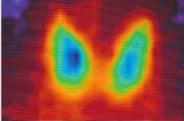({ }^{131} mathrm{I}) undergoes beta-minus decay with a subsequent gamma emission from the daughter nucleus. Iodine in...
Question:
\({ }^{131} \mathrm{I}\) undergoes beta-minus decay with a subsequent gamma emission from the daughter nucleus. Iodine in the body is almost entirely taken up by the thyroid gland, so a gamma scan using this isotope will show a bright area corresponding to the thyroid gland with the surrounding tissue appearing dark. Because the isotope is concentrated in the gland, so is the radiation dose, most of which results from the beta emission. In a typical procedure, a patient receives \(0.050 \mathrm{mCi}\) of \({ }^{131} \mathrm{I}\). Assume that all of the iodine is absorbed by the \(0.15 \mathrm{~kg}\) thyroid gland. Each \({ }^{131} \mathrm{I}\) decay produces a \(0.97 \mathrm{MeV}\) beta particle. Assume that half the energy of each beta particle is deposited in the gland. What dose equivalent in Sv will the gland receive in the first hour?
Step by Step Answer:

College Physics A Strategic Approach
ISBN: 9780321907240
3rd Edition
Authors: Randall D. Knight, Brian Jones, Stuart Field





